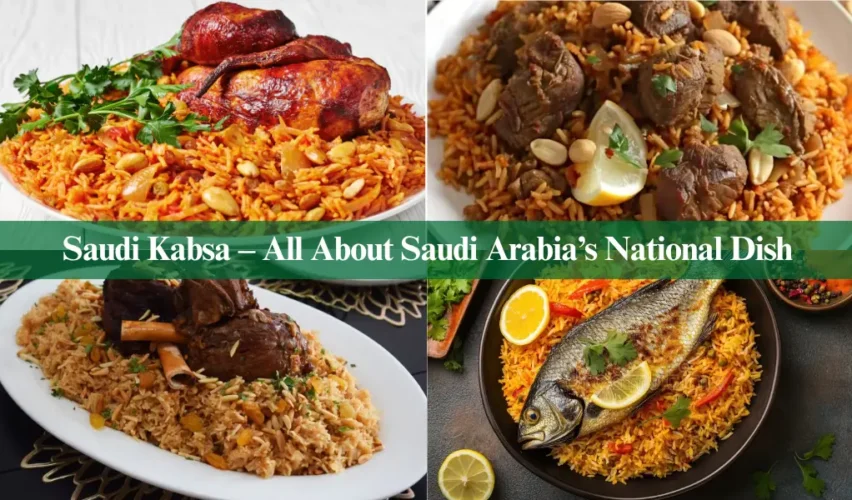Do you know what’s the national dish of Saudi Arabia? It’s Kabsa, a traditional rice dish with tender meat and aromatic spices. But Kabsa is so much more than a meal. It’s a symbol of hospitality and cultural pride. Here’s an all-you-need-to-know about why it holds such a special place in Saudi hearts.
What is Kabsa كبسه?
Kabsa (كبسه) is a traditional Saudi Arabian dish made with long-grain rice, meat (commonly chicken, lamb, or beef), vegetables, and a blend of aromatic spices such as black lime, cardamom, cinnamon, cloves, and bay leaves. It is typically cooked in a single pot so the ingredients absorb the flavors deeply.
Did You Know?
The name “Kabsa” is derived from the Arabic word kabs, which means “to press” or “to squeeze,” referring to the way the ingredients are cooked tightly together.
Origins and History of Kabsa
You should know that Kabsa was first made in the Arabian Peninsula, particularly in Saudi Arabia, where it evolved as a staple of Bedouin culinary tradition. Its origins are linked to the nomadic lifestyle, where cooking hearty one-pot meals was both practical and nourishing. Over time, Kabsa became a symbol of hospitality and generosity, often served at special occasions. It also shares similarities with other regional rice dishes, but its unique spice mix sets it apart.
What Ingredients are Needed to Make Kabsa?
Basmati rice, chicken or lamb, tomatoes, onions, garlic, and a mix of spices such as cardamom, cloves, cinnamon, black lime, and bay leaves are the main ingredients for making Kabsa. Additional ingredients include vegetable oil, salt, black pepper, and optional garnishes like raisins, almonds, or pine nuts for added flavor and texture.
Key Ingredients in Kabsa
In a well-cooked Kabsa, all ingredients (even the smallest amounts of spices) add significance. Here are the ingredients and the importance they hold in the dish:
- Rice
The foundation of Kabsa is long-grain basmati rice. It is known for its fragrant aroma and ability to absorb the rich flavors of the spices and meat. The rice is usually cooked in the same pot as the meat, allowing it to soak up all the savory juices. - Meat (Chicken, Lamb, or Beef)
Kabsa traditionally features chicken or lamb, but beef or even camel can be used depending on the region or occasion. The meat is usually seared or boiled with whole spices before being layered with the rice. - Spices
The soul of Kabsa lies in its distinctive spice mix. Common spices include cardamom, cinnamon, cloves, black lime (loomi), bay leaves, nutmeg, black pepper, and saffron. These spices give Kabsa its warm, complex, and slightly tangy flavor profile. - Vegetables and Garnishes
Tomatoes, onions, and garlic are typically sautéed to create a rich base. Some recipes include carrots or bell peppers. Garnishes like fried nuts (almonds or pine nuts), raisins, and chopped parsley are added for texture and a touch of sweetness.
How is Kabsa Cooked?
Kabsa is cooked by first sautéing onions, garlic, and spices, then browning the meat. Tomatoes and water are added to create a broth, in which the rice is cooked until tender. The dish is simmered in one pot so that the flavors blend in properly. Kabsa is also often garnished with nuts and raisins.
Different Kabsa Cooking Methods
Kabsa can be prepared using various cooking methods. Regional and personal preferences influence the technique, from traditional stovetop simmering to baking or grilling the meat separately. Here’s how this traditional rice dish cooked in different ways:
- Traditional Cooking Method
Kabsa is traditionally cooked in a single large pot. The meat is first browned with spices and onions, then simmered with water to form a flavorful broth. Rice is added and cooked until it absorbs the liquid and becomes tender. The dish is often finished by steaming the rice gently to allow all flavors to meld. - Variations in Technique
Some cooks prefer baking the dish after the initial stovetop preparation to deepen the flavor. In certain regions, the meat is grilled or roasted separately and then served over the rice. Others might include saffron-infused water or rose water for a fragrant twist. - Cooking Vessels Used
Kabsa is usually prepared in a large, heavy-bottomed pot called a “deera” or a “margal”, ideal for slow cooking and even heat distribution. In modern kitchens, pressure cookers and rice cookers are also used to save time without compromising flavor.
Types of Saudi Kabsa
Though Kabsa has a standard base of rice, meat, and spices, there are several popular variations of this dish. These variations are usually based on the type of protein used and the region where it’s made. These differences reflect the diverse culinary influences across Saudi Arabia. Each version has its own unique flavor, preparation method, and cultural significance, yet all are unified under the beloved name of Kabsa.
-
Chicken Kabsa (Kabsa Dajaj)
Chicken Kabsa is the most common and widely enjoyed variation. It uses bone-in chicken, typically simmered with tomatoes, onions, and the signature Kabsa spice blend. The chicken may be pan-fried for extra flavor before being added to the pot or grilled and placed atop the rice just before serving. It’s especially popular for everyday meals and family gatherings.
-
Lamb Kabsa
Lamb Kabsa, known for its rich and bold flavor, is often reserved for special occasions, weddings, or large feasts. The lamb is usually slow-cooked to become tender and juicy, allowing its deep flavor to infuse the rice. This version pairs well with toasted nuts and raisins for added texture and sweetness.
-
Seafood Kabsa
This Kabsa type is popular in coastal regions like Jazan and the Eastern Province. Seafood Kabsa features fish or shrimp instead of red meat or poultry. The rice is often lighter in seasoning to complement the delicate taste of the seafood, and fresh herbs or lemon may be used for garnish. It’s a lighter but equally flavorful twist on the classic.
-
Regional Variations Across Saudi Arabia
Each region and many cities of Saudi Arabia brings their own touch to Kabsa. In Najd, the dish tends to be spicier, while in the Hejaz region, Kabsa may be milder and more tomato-based. In the Southern regions, it’s often cooked over firewood in traditional metal pots, enhancing its smoky aroma. These regional differences reflect the rich cultural fabric of the Kingdom.
Kabsa in Saudi Culture
As aforementioned, Kabsa holds a special part of the culture of Saudi Arabia. It is usually served during special occasions such as weddings, Eid celebrations, family gatherings, and when hosting esteemed guests. Traditionally, Kabsa is the centerpiece of meals or big feasts. In fact, Saudi Kabsa is often the first dish presented at both lunch and dinner, signifying respect and warm welcome.
Kabsa holds a deeply rooted place in Saudi culture, symbolizing hospitality, generosity, and communal unity. Traditionally, Kabsa is the centerpiece of meals served during special occasions such as weddings, Eid celebrations, family gatherings, and when hosting esteemed guests. It is often the first dish presented at both lunch and dinner, signifying respect and warm welcome.
Since old times to today, Kabsa is served on a single large platter, placed on the floor with guests seated around it. This communal style of dining serves around four to ten people from one dish. These reasons are why Kabsa became a symbol of hospitality and generosity. Moreover, modern serving styles like buffets and individual portions have become more common in restaurants and urban homes.
What is Mufattah?
Al-Mufattah is a traditional Saudi serving method where lamb or poultry is presented over rice with the legs and wings removed, leaving only the back portion. Exclusive to Saudi regions, it is commonly used during major banquets and special occasions to honor guests.
Where to Eat Kabsa in Saudi Arabia?
Kabsa is a culinary staple in Saudi Arabia, and enjoying it at a local restaurant is a must for tourists. And if you are a local, and don’t know about the best Kabsa spot, you’re definitely an imposter.
Anyway, here are some top restaurants that offer some of the most authentic and delicious Kabsa dishes across the Kingdom.
1. Al Romansiah
Al Romansiah is one of the most popular local chains serving classic chicken and lamb Kabsa. Known for clean, consistent flavors and large portions, it’s a go-to spot for both locals and tourists seeking a no-fuss, authentic Saudi meal.
2. Najd Village – Riyadh
Najd Village offers a traditional dining experience with rustic décor and floor seating. It specializes in Najdi-style Kabsa with rich spices and tender meat, making it an excellent place to enjoy Saudi cuisine in a heritage-inspired setting.
3. Raydan – Jeddah
Raydan combines simplicity with satisfaction: floor seating and large family-style servings of Kabsa, mandi, and madfon. Focused on bold traditional flavors and generous portions, it’s a go-to for hearty Saudi feasts.
4. Aseeb Najd – Riyadh
Aseeb Najd blends creativity with tradition, offering dishes like pumpkin Kabsa alongside classic options. The stylish interior and curated menu appeal to younger diners and food lovers looking for a modern twist on Saudi culinary traditions.
5. Kabsa Alhassaoah – Dammam
Located in Dammam’s Al Jalawiyah district, Kabsa Alhassaoah is renowned for its authentic “Hasaweya” chicken Kabsa. Reviewers praise its richly spiced flavors and home-like taste, complemented by welcoming service and traditional ambiance.
If you’re searching for the best Kabsa restaurants near you in Saudi Arabia, look no further than KnowKSA. We’ve listed top-rated food places with detailed reviews, local recommendations, and must-try dishes. Start your delicious journey with KnowKSA today!
Conclusion
Kabsa, the national dish of Saudi Arabia, is a ride of flavorful delight. However, it goes beyond taste. After all, this aromatic rice dish tells a story of tradition, and cultural pride. Whether served at family gatherings, festive occasions, or elegant restaurants, Kabsa continues to bring people together. If you are a tourist here in KSA, trying Kabsa is a must. Check out above recommendations or check out KnowKSA to find out more.




